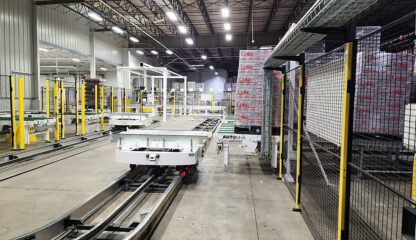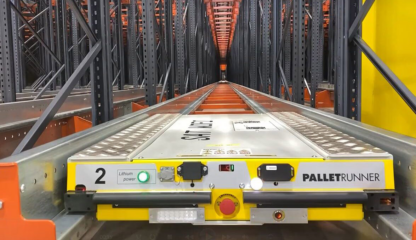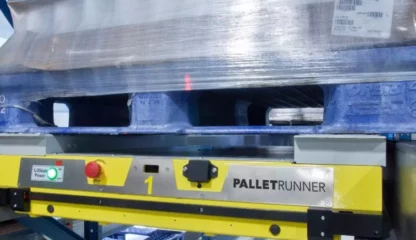Warehouse automation, also referred to as automated storage and retrieval system (AS/RS), is the use of technology and machinery to automate various tasks and processes within a warehouse or distribution center. It involves the implementation of advanced systems and robotics to streamline and optimize operations, from inventory management to order fulfillment. Automha Americas Automation manufactures and integrates warehouse automation modular products and software.
Benefits of Automha Americas Automated Warehouse Systems
Automated pallet storage systems significantly improve operational efficiency by reducing manual labor and human errors. Automated systems can handle tasks such as sorting, picking, and packing with speed and precision.
An AS/RS warehouse reduces labor costs over time, as fewer human workers are needed for repetitive tasks. It also minimizes the risk of costly errors in inventory management and order processing.
With automated systems, orders can be processed and shipped more quickly, leading to improved customer satisfaction. This is especially crucial in today’s fast-paced e-commerce environment.
Automation systems are highly accurate, leading to reduced errors in order picking and inventory management. This results in fewer shipping mistakes and improved inventory control.
Automated systems can make better use of available storage space, maximizing the warehouse’s capacity without the need for physical expansion.
Warehouse automation systems collect valuable data on inventory levels, order trends, and operational efficiency. This data can be analyzed to make informed decisions and optimize processes further.
Automation solutions can be scaled to accommodate growing business needs. As a company expands, it can easily adapt and add automation technology to meet increased demand.
Embracing warehouse automation gives companies a competitive edge in a rapidly evolving market. Businesses that can fulfill orders quickly and accurately gain a reputation for reliability.
Automation can reduce the physical strain on workers and minimize the risk of accidents and injuries associated with manual material handling.
When is it time for automation?
There are many reasons a company may consider investigating warehouse Automation (some of which are expanded on below). Although investment and process changes by implementing automation ranges considerably, it would be fair to say that before you embark on the process you need to establish a few main milestones:
- Goals you want to achieve by implementing warehouse automation.
- Establishing a budget for the project. This will allow the process to be more streamline and quicker to the point
- Form an internal project team that are responsible to work with vendor(s)
- Have readily available as much data on your process as possible, simply put, more the better
If a company experiences significant growth in its operations, such as a substantial increase in inventory or order volume, the existing pallet racking system may become inefficient. Automated systems can handle higher throughput and storage capacity, making them suitable for rapidly growing businesses.
As inventory management becomes more complex, with a wide range of SKUs (stock-keeping units) and varying product dimensions, an automated system’s ability to efficiently manage and retrieve items can become a significant advantage.
If there is a need to fulfill orders more rapidly to meet customer demands, an automated system can provide faster and more accurate order picking and packing, reducing order processing times.
Automated systems are known for their high accuracy, which can be critical in industries where order accuracy is paramount. If a business is experiencing too many errors in order picking or inventory management with a manual system, automation can help mitigate these issues.
Labor costs, including hiring, training, and maintaining a workforce for manual material handling tasks, can be a significant expense. Transitioning to automation can lead to long-term cost savings by reducing the need for manual labor.
If warehouse space is limited, and there is a need to maximize storage capacity, automated systems can often utilize vertical space more efficiently than traditional pallet racking.
Businesses with seasonal fluctuations in demand may benefit from the flexibility of automated systems, which can handle variations in order volume more easily than a fixed pallet racking system.
Evaluating the ROI of transitioning to an automated system is crucial. It involves calculating the upfront costs of automation compared to the expected long-term savings in labor, increased efficiency, and reduced errors.
Advancements in warehouse automation technology may make automated systems more accessible and cost-effective over time. Regularly assessing the state of automation technology can help determine when it makes sense to make the switch.
In some industries, staying competitive requires keeping up with or even surpassing the automation capabilities of competitors. Falling behind in automation can result in lost market share.
It’s essential to conduct a thorough analysis of the specific needs and goals of your business before deciding to replace a pallet racking system with an automated warehouse system. In many cases, a phased approach to automation, where certain processes or areas of the warehouse are automated gradually, can be a practical and cost-effective strategy. Additionally, consulting with experts in warehouse design and automation can provide valuable insights into the best timing and approach for transitioning to automated systems. Our warehouse automation consultants have the expertise and experience to guide you the decision, and to provide the best solution for your challenges.
Automha Warehouse Automation Solutions for Pallet Storage and Retrieval
Automha Americas Automation Corp manufacturers modular automated pallet storage products and solutions. Our solutions are custom made for every unique storage environment.
Automha Americas AS/RS Pallet Storage Automation is the all-in-one solution for high-density, multiple deep-lane warehouses and distribution centers. Automha’ modular, customizable automated storage and retrieval systems adapt to a variety of loads and temperature ranges. We strategically design solutions to simplify your warehouse operations.
Automha world-class high-density AS/RS solutions deliver the flexibility, reliability and efficiency required in today’s manufacturing, storage warehouses and distribution centers.
As the manufacturer, integration expert, WMS Software developer, and service provider, we offer a turnkey approach that eliminates the headaches of system integration where all components work seamlessly together.
Why Choose Automha Americas Automation?
AutoSatMover and SuperCap are class-leading technologies.
Automha offers customized solutions tailored to meet specific customer requirements. This flexibility allows Automha to cater to a wide range of industries and operational needs. This includes are ability to create conveyor, machines for any situation.
“Doing it all” (from engineering to manufacturing to service) gives our clients the piece of mind knowing Automha has full control of every aspect of the project.
With years of experience in the industry, Automha has developed extensive knowledge and expertise in automated material handling systems. Our experience allows us to deliver effective solutions that “just work” – this isn’t always the case for our competitors.



